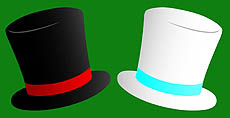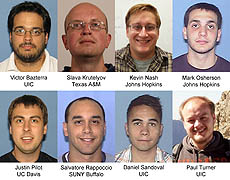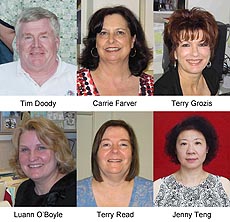Unexpected top quarks
 |
| Matter-antimatter pairs of top quarks are thought to be an excellent signal for new physics. If more events of this kind are observed, it would be an exciting indication that we'd found something unexpected. |
The Standard Model of particle physics totally rocks. It answers a ton of questions and simplifies our understanding of the matter of the universe, boiling it down to just a handful of particles and four forces. However, the Standard Model isn't a theory of everything. It's just a good working model with great, but incomplete, explanatory power. There are questions that it doesn't answer. For instance, according to the Standard Model, the mass of the Higgs boson should be huge. Yet the discovered Higgs boson has a low mass, and we don't know why.
Since the interaction between the Higgs boson and the top quark is a big reason that the Higgs mass is predicted to be so high, it stands to reason that studying top quark production — looking for anomalies between prediction and observation — would be a good place to look for answers. Perhaps some subtle and unexpected interplay between Higgs bosons and top quarks will not only reveal clues as to why the mass of the Higgs boson is unexpectedly low, but could lead to new physics that has an even wider applicability.
The top quark is the heaviest known subatomic particle, so there are only a handful of ways in which a matter-antimatter pair of top quarks can be made. It's just pretty hard to concentrate enough energy in the right way to make two of them, and they are therefore relatively rare, even at the LHC. Note that "relatively rare" means that the LHC can make about one top matter-antimatter pair per second. That's much lower than the maximum collision rate at the LHC, which can approach a billion per second.
If making top matter-antimatter pairs is rare, making hypothetical higher-energy particles is rarer still. But given that these hypothetical particles have a huge mass, it is energetically possible for them to decay into a top matter-antimatter pair. This uncommon decay combined with the relative rareness of top quark production means that these kinds of events are fertile ground for searching for heavy and as-yet-undiscovered particles: Since top quark production is relatively rare, potential new particles that decay into top quarks won't be buried under the deluge that occurs when lighter decay particles are studied.
For this and myriad other reasons, looking at the production of top quark matter-antimatter pairs and comparing the measurement to the prediction is considered to be a likely way to find new physical phenomena. CMS scientists looked for an unexpected excess in the number of pairs of top quarks, but no excess was observed. The Standard Model continues to reign, and scientists continue to poke at it, trying to find cracks in the theory.
—Don Lincoln
 |
| These US CMS scientists contributed to this analysis. |
 |
| These Fermilab-based staff play crucial administrative roles in ensuring that the CMS Center, the LHC Physics Center and the US CMS Operations Program all function smoothly. |
|